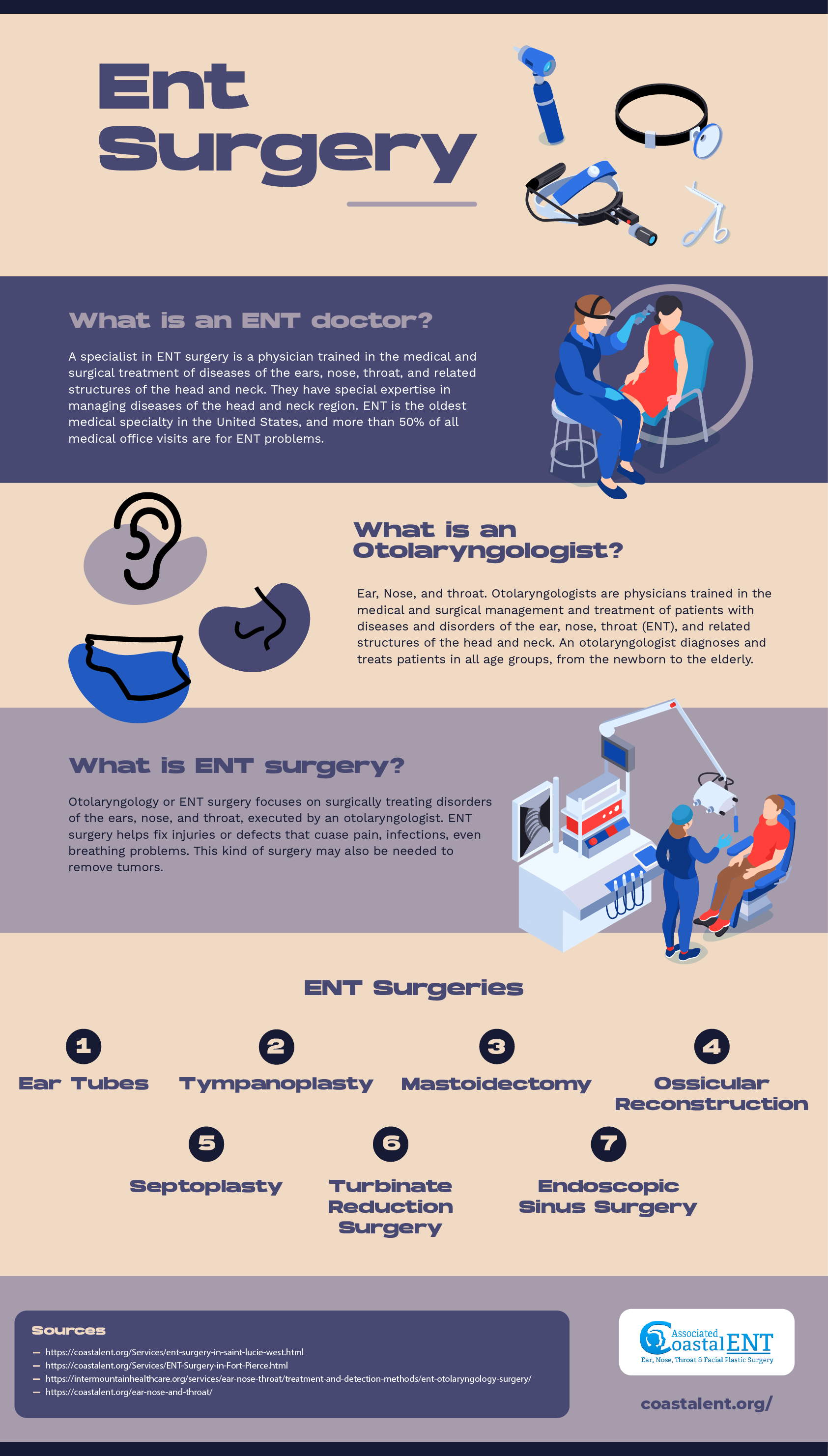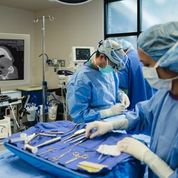What Is A Common Procedure For An ENT?
ENT (ear, nose, and throat) is a branch of medicine that focuses on the diagnosis and treatment of diseases and conditions that affect the head and neck. ENT specialists, also known as otolaryngologists, have a wide range of medical skills and procedures to help diagnose and treat many conditions.
A common procedure for an ENT is an endoscopy. This procedure involves using a small camera to examine the inside of the throat, sinuses, and nasal passages. During an endoscopy, the otolaryngologist can look for signs of infection, inflammation, or physical obstruction. Depending on the findings, the otolaryngologist can take a biopsy or perform surgery to remove any abnormal tissue or blockages.
Other common procedures include hearing tests, allergy testing, and sleep studies. Hearing tests are used to determine whether a patient has hearing loss and what type of hearing loss they have. Allergy testing helps to determine what allergens the patient is sensitive to so that they can be avoided in the future. Lastly, sleep studies are used to evaluate the patient’s sleep patterns and diagnose any sleep disorders they may have.
All these procedures help ENT specialists diagnose and treat various conditions in the head and neck. Collectively, they are an essential part of the ENT’s practice.
An Overview of ENT Procedures
Ear, nose, and throat (ENT) procedures are performed to diagnose and treat a wide range of conditions affecting the head and neck. ENT doctors, also known as otolaryngologists, are specially trained to identify and treat diseases and abnormalities of the ears, nose, and throat. Common ENT procedures include endoscopic sinus surgery, tonsillectomy, tympanoplasty, and tracheostomy.
Endoscopic sinus surgery is a procedure used to remove obstructions or open up sinus passages to improve sinus drainage. Tonsillectomy is an operation to remove the tonsils, which are two small glands on either side of the throat. Tympanoplasty is used to reconstruct the eardrum and middle ear bones, typically to repair a hole in the eardrum or restore hearing loss. Tracheostomy is a procedure in which a tube is inserted into the trachea to help with breathing.
In addition to these common ENT procedures, ENTs can also perform endocrine surgery, laser surgery, and reconstructive surgery. Endocrine surgery is used to treat thyroid and parathyroid diseases, while laser surgery is used to remove tumors and address other issues. Reconstructive surgery is used to repair facial deformities, including cleft lip and palate.
It is important to consult with an ENT doctor if you or a loved one is experiencing symptoms such as ear infections, sinusitis, hearing loss, hoarseness, or nasal obstruction. An ENT doctor can assess the situation and determine the best course of action.
Common ENT Diagnostic Tests
ENT or Ear, Nose, and Throat specialists are medical professionals who specialize in diagnosing and treating conditions that affect the ears, nose, and throat. Common ENT procedures involve diagnosing and treating conditions that affect the ears, nose, and throat, such as hearing loss, sinus infections, allergies, sleep apnea, and more. To determine the cause of a patient’s symptoms, an ENT may perform a variety of diagnostic tests.
The most common diagnostic test in ENT is an audiogram, which helps to diagnose hearing loss. An audiogram is a non-invasive test that measures the patient’s ability to hear different frequencies and sounds. Other common diagnostic tests for ENT include endoscopy, which is used to examine the throat and vocal cords; imaging tests such as X-rays, computed tomography (CT) scans, and magnetic resonance imaging (MRI) scans; and blood tests, which are used to check for infection or allergies. Depending on the diagnosis, the ENT may also recommend additional tests, such as a sleep study or a tympanometry.
ENTs also specialize in surgical procedures, which can be used to treat various conditions. Common surgical procedures include tonsillectomy, adenoidectomy, and myringotomy. ENTs may also treat ear infections, polyps, and tumors.
Overall, ENTs are experts in diagnosing and treating conditions that affect the ears, nose, and throat. Common ENT procedures include a variety of diagnostic tests and surgical procedures, which can help diagnose and treat conditions that affect the ears, nose, and throat.
Types of Common ENT Treatments
ENT (Ear, Nose, and Throat) specialists provide a variety of medical services to diagnose and treat conditions of the head and neck. Common ENT procedures can include removing tonsils, evaluating hearing loss, or repairing perforations in the eardrum. Depending on the patient’s symptoms and diagnosis, the ENT specialist may use a number of treatments to alleviate the patient’s symptoms.
Some of the most common ENT treatments are endoscopic evaluation, balloon sinuplasty, and tonsillectomy, to name a few. Endoscopy is used to diagnose and treat sinus, ear, and throat diseases. It is a minimally invasive procedure that uses a small camera to examine the interior of the nasal passage. Balloon sinuplasty is a minimally invasive procedure used to open up blocked nasal passages and improve airflow. Finally, tonsillectomy is a procedure used to remove enlarged tonsils and help reduce the risk of infection.
In addition to these treatments, ENT specialists may also prescribe medications, recommend lifestyle changes, or provide referrals to other medical specialists when necessary. ENT treatments vary from patient to patient, so it is important to discuss your treatment options with your doctor. They can help you make an informed decision and ensure you receive the most effective treatment for your condition.

Costs of Common ENT Procedures
An Ear, Nose and Throat (ENT) specialist can treat a variety of ailments and conditions. Depending on the individual’s needs, the ENT may suggest a variety of treatments. One of the most common procedures is a tonsillectomy, which is the removal or partial removal of the tonsils. Other common ENT procedures include ear tube placement, earwax removal, and septoplasty (correction of a deviated septum). Each procedure can come with its own set of costs, depending on the complexity of the procedure.
For example, a tonsillectomy can range from $1,500 to $5,000, depending on the patient’s insurance coverage and the complexity of the procedure. Ear tube placement can range from $2,000 to $5,000, while earwax removal is relatively inexpensive with costs typically ranging from $100 to $250. Septoplasty, for a deviated septum, can range from $2,500 to $5,000.
Each patient’s needs are different, and so these prices should not be taken as a concrete estimate. It is best to contact the ENT office for a more accurate cost estimate. In addition, many ENT offices may offer payment plans, so it is wise to inquire about those as well. As always, it is important to take into account the expertise of the ENT when considering the cost of the procedure.
Risks Associated with Common ENT Procedures
When it comes to common ENT procedures, such as tonsillectomies, ear tube insertions, and adenoidectomies, there are risks involved. It is important for patients to be aware of these risks before undergoing any of these procedures. ENT procedures are relatively safe, but there are some potential risks associated with them.
One of the most common risks associated with ENT procedures is bleeding. Bleeding can occur during or after the procedure, and can sometimes lead to a need for a blood transfusion. Infection is another risk associated with ENT procedures, as any foreign material introduced into the body can cause an infection. In addition, anesthesia carries its own set of risks, including nausea, vomiting, and allergic reactions.
Patients should also be aware of potential complications that may arise after the procedure. Post-operative swelling, pain, and difficulty in breathing can occur. In some cases, additional surgery may be required to address any complications from the procedure.
It is important for patients to discuss any potential risks associated with an ENT procedure with their doctor prior to undergoing the procedure. Patients should make sure they are fully informed about the procedure and any associated risks, and should be aware of any potential complications they may experience after the procedure.
Preparation for Common ENT Procedures
ENT (ear, nose, and throat) procedures can be intimidating but they don’t have to be. As with any medical procedure, preparation is key. Knowing what to expect and understanding the steps involved can help make the process a smoother one.
Before undergoing any ENT procedure, a patient should first have a comprehensive physical exam. This includes a review of their medical history and a screening of their ears, nose, and throat. The doctor will also likely discuss any medications the patient is taking, as certain drugs can interfere with the procedure.
The doctor may also perform an imaging test, such as a CT scan or an MRI, to help them better understand the patient’s condition. This will help the doctor determine the best course of treatment and make sure the procedure is performed safely.
Once the patient has been examined and the doctor has a clear understanding of the condition, the procedure can be scheduled. During the procedure, the patient should expect to be asked to lie down in a comfortable position and may be given a sedative to help them relax. The doctor will then discuss the procedure in detail and explain any risks or potential side effects.
By understanding the preparation involved in common ENT procedures, patients can make the process easier and reduce any anxiety they may have. Knowing what to expect and being informed can make the experience more comfortable and successful.
FAQs About the What Is A Common Procedure For An ENT?
1. What type of issues do ENTs typically treat?
ENTs (Ear, Nose, and Throat doctors) specialize in diagnosing and treating conditions related to the ear, nose, and throat. This includes issues such as ear infections, sinus infections, tonsillitis, hearing loss, balance disorders, and allergies.
2. How is a common procedure for an ENT performed?
Common procedures performed by ENTs include ear tube insertion, tonsillectomy, adenoidectomy, and endoscopic sinus surgery. Procedures vary depending on the individual case, but typically involve using an endoscope to examine the affected area and then performing a surgical procedure to correct any issues.
3. What should I expect from an ENT visit?
Before any procedure is performed, the ENT will first perform a physical examination of the affected area. They may also order imaging tests, such as an X-ray or MRI, to get a better understanding of the condition. After the examination and tests, the ENT will discuss their findings with the patient and recommend the best course of action.
Conclusion
A common procedure for an ENT is an ear, nose, and throat (ENT) exam. This exam is typically done by an ear, nose, and throat specialist, and includes a physical examination of the patient’s ears, nose, and throat. During the exam, the doctor may use specialized tools to look for any abnormalities in the structures of the ear, nose, and throat. Depending on the results of the exam, the doctor may also perform other tests, such as a hearing test or a CT scan, to better diagnose any issues. The goal of an ENT exam is to identify any potential problems and provide effective treatment to improve the patient’s health.



